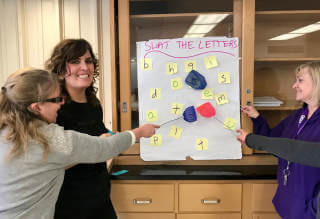
"If my students can't learn the way that I teach, how can I teach in the way they learn?" Caleb Gattegno
Comprehensible Input is the measurement of how easily someone can understand something. In this component, the SIOP framework asks teachers to consider how comprehensible key aspects of their teaching is to the students they teach.
This component of SIOP encourages teachers to consciously make the content and the language accessible to the students. The first of the three features (see below) under this component deal with making sure students understand your speech, the second wants teachers to insure students understand the task, and the final feature pertains to student understanding of the concept being taught. There it is again: that content and language connection that SIOP brings. This K-12 teaching framework encourages teachers to make sure that students can understand the lesson's content and language.
A teacher's natural reaction to the importance of making sure students are grasping the main ideas of a discussion most probably will be an emphatic, "No, duh." However, cultivating comprehension in the classroom takes more skill than merely speaking the same language as the students. The lesson's focus plays a role: its level of difficulty varies; The students' background influences the comprehensibility; Finally, the way the teacher connects the students to the content and language also has an impact.
Notice the layers: Pay attention to oral language; make sure you're making all tasks clear; get your students to interact with content in a variety of meaningful ways. Each of these influence the comprehensibility of a lesson. Let's examine these 3 features of Comprehensible Input as outlined in the SIOP Framework. As you will see, there is more to this teaching component than just 1-2-3. In fact, I'll bet you will discover the reason why so many teachers find this to be such a challenge.

Paying attention to the language that we use is important. Often, the message that we intend to send is not the one that is received. This is true both outside and inside the classroom. Comprehensible input helps teachers pay attention to the message they are sending and how that message is being interpreted. There are three parts to this: our speech, the language of the task, and the concept itself. The SIOP Component Comprehensible Input deals with these three.
Giving clear instructions is something that even the most experienced of teachers can struggle with. Explaining anything to someone is challenging. If students don't speak English very well or lack any kind of academic foundation, their understanding of the task and how they are supposed to approach it may suffer greatly. Here are 4 things that you can do to make your instructions clearer:
For more information on how to explain academic tasks clearly, check out SIOP feature #11. This is one way that teachers can help make content comprehensible to all learners.
Making sure students comprehend speech, text, and activities is paramount to student success. As Caleb Gattengo's quote at the top of the page suggests, it's all about the learner. Once we, as teachers, make the shift from how am I going to teach this to how are they going to learn this, we become more aware of our speech, the types of activities we use, and how we give instructions.

There are plenty of reasons to invite TESOL Trainers to provide professional development on SIOP to your teaching staff. Here are four of the most powerful:
Click the button below to claim your free ebook and join our mailing list.